101 Ranch Oil Company
Founded in 1908 by oil exploration pioneer E. W. Marland, The 101 Ranch Oil Company was located on the Miller Brothers 101 Ranch and headquartered in Ponca City, Oklahoma. The company’s 1911 oil discovery in North Eastern Oklahoma opened up oil development in a great region from Eastern Oklahoma west to Mervine, Newkirk, Blackwell, Billings and Garber and led to the founding of the Marland Oil Company, later renamed the Continental Oil Company, now known as Conoco.
Background
Ernest Whitworth Marland was born in Pittsburgh, Pennsylvania on May 8, 1874. Marland studied to be an attorney, receiving an LL.B. from the University of Michigan Law School at the age of nineteen in 1893. Marland moved back to Pittsburgh and set up private practice. As an attorney representing local coal and oil interests of Pittsburgher James M. Guffey, the nation’s largest oil and gas producer and the principal investor in Beaumont Texas’ Spindletop discovery, Marland became interested in geology and by the age of 33, the young lawyer had become involved in a series of local coal and oil promotions which soon made him a small fortune.
Unfortunately for Marland, the millions he had amassed were lost following the panic of 1907. By 1908, Marland was broke and without a job.
Founding
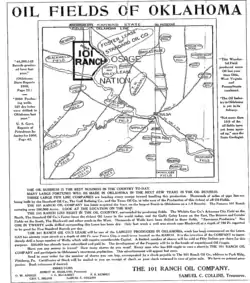
Interested in reestablishing his oil ventures, Marland came to Ponca City upon the urging of a relative, Lt. Franklin Roosevelt Kenney, who introduced Marland to the Miller brothers - Joseph "Joe" Carson Miller, Zachary "Zack" Taylor Miller and George Lee Kockernut Miller, of the famous 101 Ranch near Ponca City.
He decided that the Ranch surface geology indicated that there was oil in the area. Geology was his divining rod, he said, a science yet to be proven in the hunt for crude. Marland returned to Pittsburgh and raised $500,000[notes 1] for a new oil venture, naming it the 101 Ranch Oil Company with himself as President and taking into the company as directors, O. W. Ainslie, the chef at Pittsburgh's Boyer Hotel, J. G. McCaskey, a sauerkraut producer, Marland's relative, F. R. Kenney, a retired chair manufacturer, George Miller of the 101 Ranch, and Marland’s father-in-law, Samuel Collins who was also elected Treasurer.
Drilling for oil
Upon his return to the ranch he began drilling. The first well located near the "White House", the ranch headquarters for the Miller brothers' 101 Ranch, was a 2,500 foot dry well. The next seven wells were uneconomic gas wells and by 1910 the company was on the verge of failure.[1]
Restructure
Then John G. McCaskey, the “Sauerkraut King”, a wealthy investor and young Pittsburgh adulthood friend of Marland’s reorganized the Company. Elected President, McCaskey raised funds from Pittsburgh investors including W. H. McFadden, a retired Carnegie Steel Company executive and J. M. Weaver, a business associate of McCaskey’s. McFadden was elected vice president and general manager of the company and Weaver was elected Secretary and Treasurer.[2] In 1911 Pittsburghers held the stock of the company. These were E. W. Marland, J. G. McCaskey, W. H. McFadden, G. W. Baum, N. A. Hemphill, of Mackintosh, Hemphill & Co. a rolling mill manufacturer and business associate of W.H. McFadden, Pittsburgh Alderman J. J. Kirby, J. M. Weaver, B. H. Gibson a 1906 Princeton graduate and insurance broker, C. L. Stevens a Pennsylvania Medical Society member, J. J. Kearns, and Marland's father-in-law Samuel C. Collins. Later, McCaskey appointed Lewis Haines Wentz, an employee in his sauerkraut operation, Secretary of the company.
Ponca lease
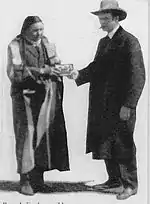
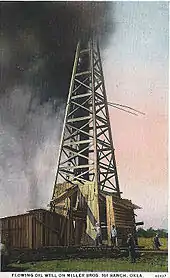
With new money, and using his practical knowledge of geology Marland choose a new well site at an elongated and isolated hill near Bodark Creek that he thought was a geological high as well as a topographic high. However, the hill Marland picked was a burial ground for the Ponca tribe. Actually the Ponca bound their dead, laid them upon scaffolds and wild animals devoured them. These scaffolds were on the crest of the hill in the exact location that Marland wanted to drill.
Marland and the Millers met with White Eagle, Chief of the Ponca and emerged with permission to drill off the crest of the hill on an allotment owned by the Ponca Indian, Willie-Cries. For a $1,000 annual payment and a 12.5% override, a lease was obtained from Willie-Cries, and on June 11, 1911, that well “Willie-Cries-For-War” struck oil and stayed in production until 1976, bringing wealth to the company and its investors. (1).
Marland Oil Company and CONOCO
The main office was in Ponca City and the company stayed in operation until November 1916 when it was sold for cash and stock in the Marland Oil Company, later (January 3, 1921), incorporated in Delaware to acquire through an exchange of stock control of the Marland Refining Co. and Kay County Gas Co. Name changed to Continental Oil Company June 26, 1929, at which time it acquired for a consideration of 2,317,266 shares of stock, the assets (subject to liabilities) of Continental Oil Company,[3] a Maine corporation, founded in 1875 as the Continental Oil and Transportation Company, based in Ogden, Utah, originally a coal, oil, kerosene, grease and candles distributor in the West.
Images
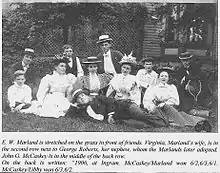 Marland and McCaskey photo, Pittsburgh 1906 |
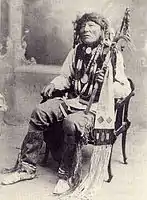 Chief White Eagle of the Ponca Tribe. |
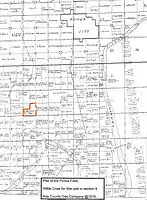 1911 Ponca Field Plat |
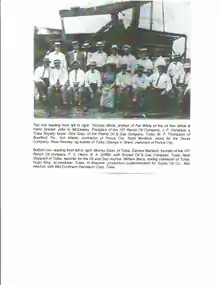 1911 gathering of 101 Ranch oil Company first well |
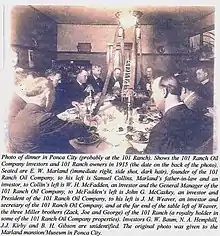 101 Ranch Oil Company celebration dinner @1915 |
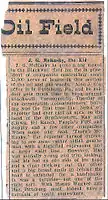 1916 News clip from Blackwell Daily @head of 101 Ranch Oil Company |
Notes
- Estimates of initial capital vary from between $500,000 to $1,000,000. The Offering Bill for 101 Ranch Oil Company @1909 is held by the CONOCO museum, Ponca City, Oklahoma.
References
- "E. W. Marland: Life and Death of an Oil Man", John Joseph Mathews, Pg. 80. (Norman: University of Oklahoma Press, (1985): ISBN 0-8061-1238-7.
- American Biography a New Cyclopedia, Volume LXV. Published under the direction of The American Historical Society, Inc. New York. 1931. pg. 126 and 127.
- Moody’s Industrial Manual, 1960.
Further reading
- "Kay County Oklahoma", Published by Kay County Gas Co. Ponca City, OK. 1919. pp. 38–43.
- "The 101 Ranch", Ellsworth Collings, University of Oklahoma Press; Reprint edition (March 1986) ISBN 0-8061-1047-3.
- Conoco : the first one hundred years: Building on the past for the future, New York: Dell (1975) OCLC 3185611